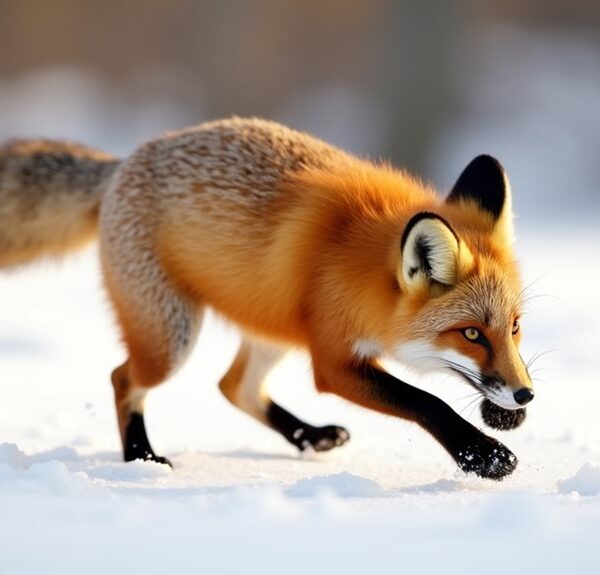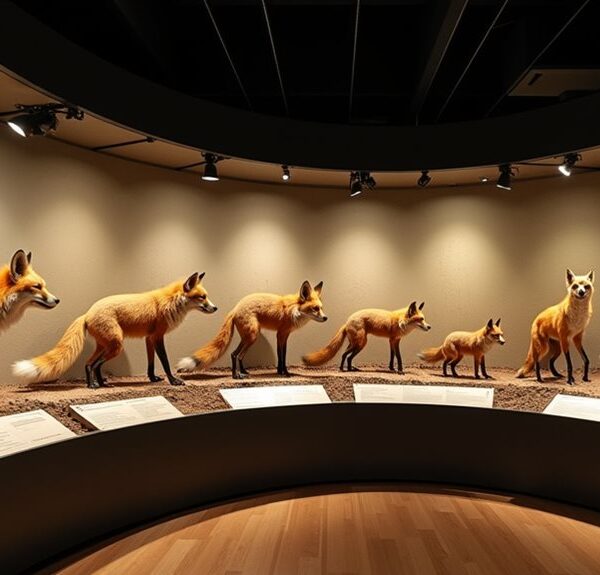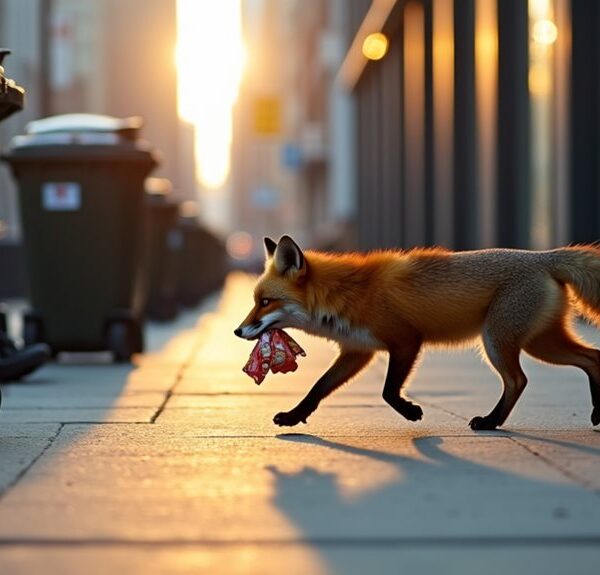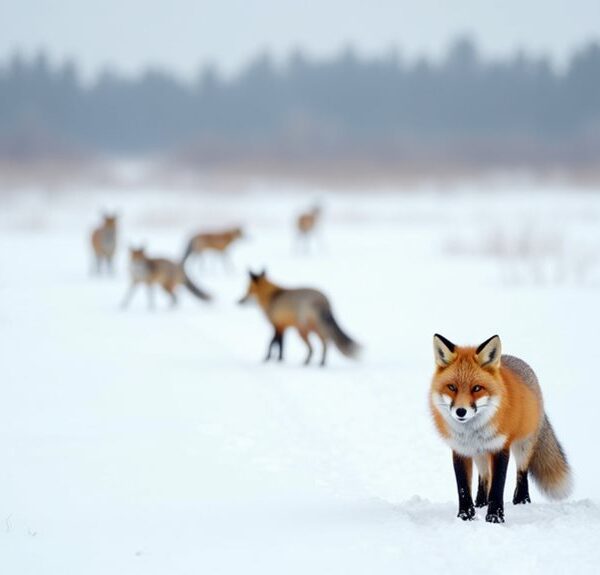Perfect fox microhabitats feature balanced edge environments where forests meet open areas. You’ll find foxes thriving in spaces with varied vegetation density—thick enough for hiding but open enough for hunting. They prefer dens with multiple exits, often on south-facing slopes for winter warmth and under porches in urban settings. The ideal habitat connects protective thickets to hunting grounds through strategic corridors. Urban foxes adapt remarkably well, using parks and gardens when natural spaces diminish. Discover how these clever creatures create homes almost anywhere.
Contents
- 1 The Critical Role of Edge Habitats for Fox Populations
- 2 Vegetation Density: Finding the Perfect Balance
- 3 Den Site Selection Across Diverse Landscapes
- 4 Seasonal Shifts in Microhabitat Preferences
- 5 Urban Fox Adaptations: From Parks to Backyards
- 6 Prey Distribution and Hunting Corridor Design
- 7 Topographical Features That Attract Fox Territories
- 8 Human Disturbance: Threshold Levels and Adaptation Strategies
- 9 Final Thoughts
The Critical Role of Edge Habitats for Fox Populations
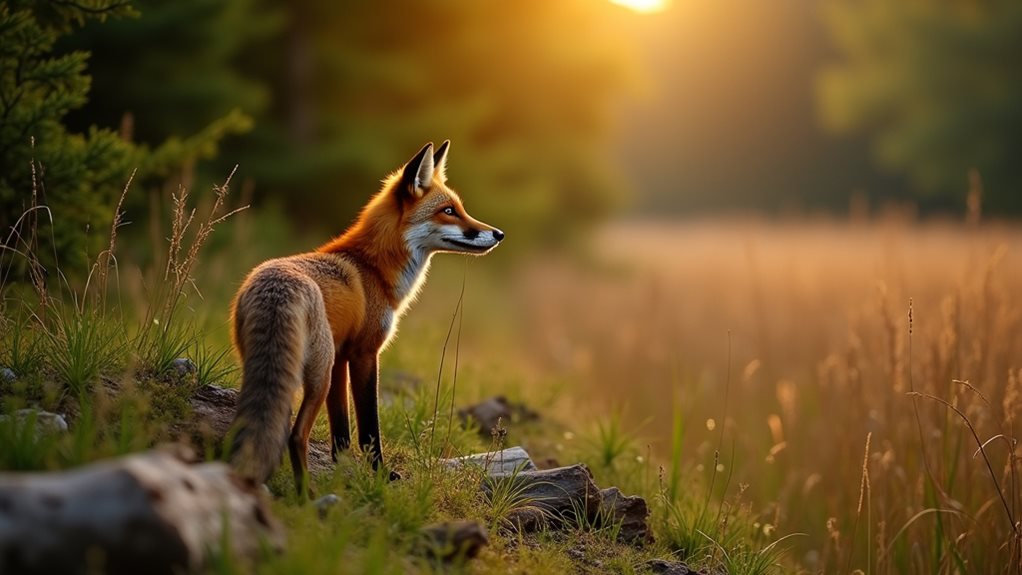
When you observe foxes in their natural environment, you’ll notice they don’t distribute themselves randomly across terrains. These clever creatures prefer edge habitats—those transition zones where forests meet meadows or agricultural lands border woodlands.
Edge dynamics create perfect hunting grounds for foxes, offering them cover while providing access to prey. Unfortunately, habitat fragmentation threatens these essential boundaries, disrupting corridor connectivity that foxes need for safe travel between territories.
You’ll find that interspecies interactions intensify at these edges, where foxes compete with coyotes and other predators for resources. During seasonal migration periods, these edges become even more important as foxes adjust their ranges to follow food availability. Additionally, as urban foxes adapt to human-altered landscapes, these edge habitats play a crucial role in their survival strategies.
If you’re hoping to spot a fox, focus on these boundary areas at dawn or dusk—you’re much more likely to catch a glimpse of these adaptable hunters going about their business!
Vegetation Density: Finding the Perfect Balance
When you’re examining ideal fox habitats, you’ll notice that vegetation density creates a delicate balance between hiding spots and hunting grounds.
You’ll find foxes thrive where dense brush offers safety from predators while adjacent clearings provide access to prey like mice and rabbits.
The quality of these shelter zones, measured by canopy coverage and undergrowth thickness, determines whether a fox will establish a long-term den or simply pass through the area. In urban environments, red foxes adapt to their surroundings by utilizing gardens and parks, which can provide vital food sources during scarcity.
Predator Avoidance Coverage
Although foxes possess remarkable adaptability, they’ll still need strategic vegetation density to truly thrive in their microhabitats.
When you examine successful fox territories, you’ll notice they’ve mastered the art of predator detection while maintaining excellent camouflage strategies. Their survival depends on this delicate balance of coverage and visibility.
You’ll find these critical elements in perfect fox predator avoidance zones:
- Partially obstructed sightlines that allow foxes to see approaching threats while remaining hidden
- Multi-layered vegetation providing escape routes in multiple directions
- Strategic clearings where they can quickly assess surroundings without exposing themselves
You’d be amazed at how foxes utilize these environments!
They’ll often create multiple entrance points to their dens, guaranteeing they’re never cornered by larger predators like coyotes or eagles. Additionally, their adaptability to urban environments often showcases their ingenuity in avoiding predators while navigating human-altered landscapes.
Food Accessibility Zones
The ideal fox microhabitat strikes a delicate balance between vegetation density and open space, creating perfect food accessibility zones.
You’ll notice foxes thrive where they can easily move between cover and feeding areas, maximizing their hunting success without excessive energy expenditure.
When you’re examining fox territories, look for areas with high food source diversity.
These clever creatures don’t rely on just one meal option! They’ll adapt their seasonal forage patterns, shifting from berries and insects in summer to small mammals in winter.
You might spot fox trails connecting dense protective thickets to productive hunting grounds—these pathways reveal their strategic approach to survival.
The smartest foxes establish territories with varied vegetation heights, giving them both stalking cover and clear sightlines to spot prey.
Interestingly, red foxes exhibit omni-diet behavior that allows them to thrive in diverse environments.
Isn’t it fascinating how they’ve mastered this delicate ecological balance?
Shelter Quality Measurements
Many shelter quality measurements rely on precisely calculating vegetation density for foxes, striking that perfect balance between protection and visibility.
You’ll notice foxes prefer areas where they can hide comfortably while maintaining escape routes. When evaluating potential fox habitats, look for these three key elements:
- Diverse shelter materials – combination of fallen logs, rock crevices, and dense brush that provide multiple hiding options
- Optimal coverage ratio – 60-70% vegetation density offering protection without impeding movement
- Effective temperature regulation – shelters that buffer against seasonal extremes, staying cool in summer and warm in winter
You can evaluate these qualities using simple quadrat sampling techniques. Additionally, red foxes often select habitats characterized by good vegetation cover that enhances both safety and resource availability.
Den Site Selection Across Diverse Landscapes
You’ll notice striking differences in how foxes choose their dens in city environments versus countryside settings, with urban foxes often tucking themselves beneath porches or within neglected structures.
Throughout the year, these clever creatures adjust their den locations to match changing conditions, perhaps selecting cooler, shaded spots during summer months and more insulated, protected sites when winter arrives.
Urban foxes also demonstrate exceptional adaptability in urban environments, which allows them to thrive despite the challenges posed by city life.
Whether you’re tracking fox populations or simply curious about wildlife adaptations, understanding these seasonal shifts and habitat preferences reveals the remarkable flexibility that has allowed foxes to thrive in our increasingly diverse environments.
Urban vs. Rural Preferences
Fox families exhibit remarkably different preferences when selecting den sites in urban versus rural environments, adapting their natural instincts to available resources.
You’ll notice urban foxes often make creative adaptations to city living that their country cousins don’t need.
When comparing these clever canids’ home choices, consider:
- Urban foxes frequently den beneath sheds, decks, and abandoned structures, while rural foxes prefer natural hillsides and dense vegetation.
- City dwellers select sites with quick access to human food sources, whereas rural foxes prioritize proximity to natural prey habitats.
- Urban den locations typically feature multiple escape routes through human infrastructure, but rural dens often utilize existing animal burrows modified to suit their needs.
Additionally, urban foxes’ dens are often located in spaces that provide safety and proximity to available food, showcasing their adaptability.
You’re witnessing remarkable adaptation in action when you spot these resourceful creatures thriving in such different environments!
Seasonal Den Adaptations
As seasons shift throughout the year, red foxes demonstrate remarkable adaptability in their den selection process, showcasing their evolutionary intelligence across diverse terrains. You’ll notice how these clever creatures prioritize den insulation during winter months, often choosing south-facing slopes to maximize sun exposure while minimizing wind impact. When spring arrives, foxes relocate to sites that offer better drainage to avoid flooded dens during rainy periods. Their mastery of seasonal camouflage is impressive – summer dens typically feature more vegetative cover, providing shade and hiding spots from predators. In autumn, they’ll begin preparing winter quarters, sometimes digging deeper chambers or adding extra entrances. Foxes are adept at selecting den sites that promote soil enhancement, contributing positively to the surrounding environment. You can often identify a fox’s seasonal priorities by observing where they establish new dens – always balancing protection from elements with accessibility to food sources.
Seasonal Shifts in Microhabitat Preferences
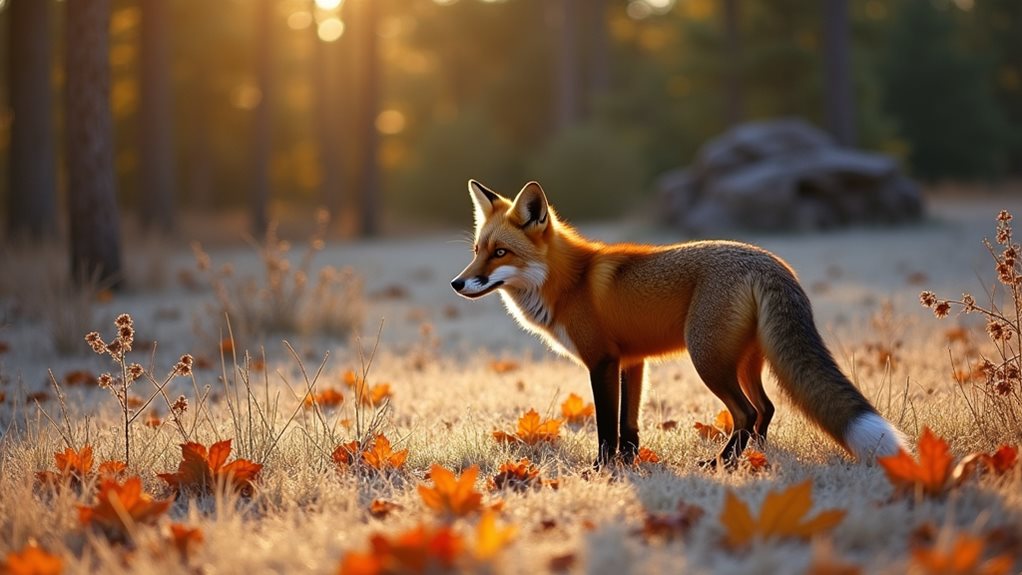
Throughout the changing seasons, wild foxes demonstrate remarkable adaptability by shifting their microhabitat preferences to match environmental conditions. You’ll notice these clever creatures adjust their living spaces based on weather patterns, food availability, and safety concerns.
Nature’s architects, foxes redesign their living spaces as seasons shift, always calculating for survival.
During winter months, they’ll seek sheltered areas that provide protection from harsh elements while maintaining access to prey. In urban areas, foxes often utilize mixed landscapes that blend natural elements with human environments, optimizing their hunting strategies.
Fox microhabitat selection is also influenced by:
- Mating behaviors – during breeding season, foxes choose secluded spots away from predators
- Territory disputes – they establish boundaries through scent marking in strategic locations
- Seasonal food sources – they relocate closer to abundant prey when available
You’ll find foxes in dense underbrush during summer heat but moving to south-facing slopes with good sun exposure when temperatures drop.
These adaptations showcase their remarkable survival instincts throughout the year.
Urban Fox Adaptations: From Parks to Backyards
While city life presents unique challenges for wildlife, urban foxes have demonstrated remarkable ingenuity in adapting to human environments. You’ll often spot these clever creatures maneuvering urban foodscapes with surprising ease, turning your neighborhood into their personal hunting grounds.
These adaptable animals have mastered nighttime foraging, waiting until you’ve tucked in for the night before raiding unsecured trash bins or helping themselves to pet food left outdoors. They’ve learned that human spaces offer reliable food sources year-round, making your backyard potentially more appealing than natural habitats!
Have you noticed how city foxes seem less skittish than their rural cousins? They’ve adjusted their behavior to tolerate human presence, creating dens under sheds or in overgrown corners of parks. In fact, urban fox populations have significantly increased, demonstrating their ability to thrive in these settings.
Their success story shows nature’s incredible resilience in our concrete jungles.
Prey Distribution and Hunting Corridor Design
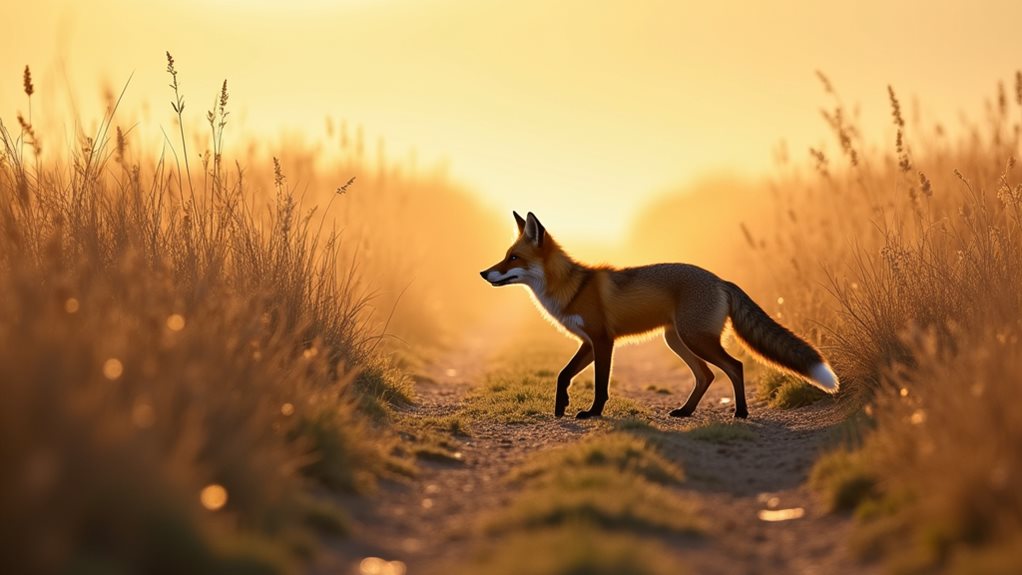
Foxes thrive where their prey follows predictable patterns, which is why understanding prey distribution becomes critical for creating effective hunting corridors.
When you’re designing spaces that support fox populations, you’ll need to take into account how habitat fragmentation impacts their hunting success.
Watch for these key elements in ideal hunting corridors:
- Multiple access points that connect to different prey-rich zones
- Linear vegetation features that allow foxes to stalk while remaining hidden
- Edge habitats where prey behavior becomes more predictable due to changes
You’ll find that foxes don’t merely hunt randomly—they learn and adapt to prey behavior.
They’re incredible opportunists! By maintaining connected corridors between fragmented habitats, you’re not only helping foxes survive; you’re supporting the entire ecosystem’s health.
Topographical Features That Attract Fox Territories
Beyond hunting corridors, the land itself shapes where fox families choose to establish their territories. You’ll notice fox territory patterns often follow ridgelines and valleys, where these clever creatures can maximize their view while maintaining protective cover.
They’re particularly drawn to areas with varied elevation – small hills adjacent to open fields provide both hunting advantages and escape routes.
When studying habitat fragmentation effects, you’ll discover foxes adapt surprisingly well to moderately fragmented environments. They’ll use hedgerows, stream corridors, and wooded patches as connecting highways between territory sections.
However, they still need core habitat areas of at least 2-3 acres for denning.
Interestingly, foxes often establish territories near water sources but typically prefer den sites on well-drained slopes – they’re practical homemakers who balance their need for resources with protection from flooding!
Human Disturbance: Threshold Levels and Adaptation Strategies
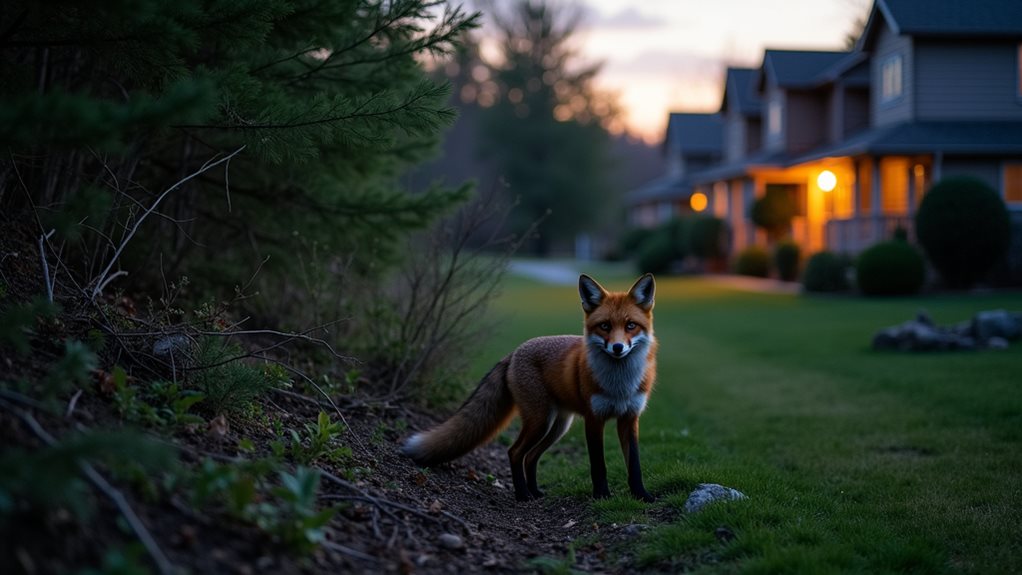
Despite common assumptions, red foxes display remarkable tolerance to human activity when specific threshold conditions are met.
You’ll notice these clever animals have developed sophisticated strategies to coexist with us, responding to human behavior patterns while maintaining necessary distance.
Fox disturbance thresholds vary based on three key factors:
- Time of day – They’re more tolerant of human activity during dawn and dusk
- Seasonal changes – Breeding seasons require considerably lower disturbance levels
- Food availability – Areas with abundant resources allow foxes to tolerate higher human presence
When you’re hiking through fox territory, remember they’re watching your patterns.
They’ll often adjust their routines around yours, demonstrating impressive adaptability.
Foxes don’t need complete isolation—just predictable human behavior they can work around!
Final Thoughts
As you explore the nuanced world of fox habitats, you’ll discover that these adaptable creatures thrive where wildness meets civilization. They’re building dens beneath your garden shed while hunting in moonlit meadows nearby. Your understanding of these microhabitats doesn’t just satisfy curiosity—it bridges the gap between human development and wildlife conservation. By respecting these clever survivors’ needs, you’re creating space where both your world and theirs can flourish together.


